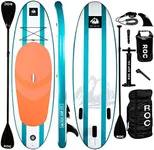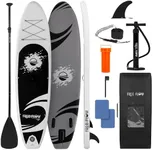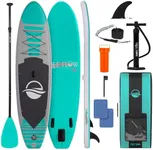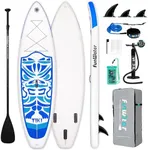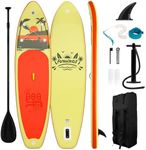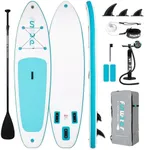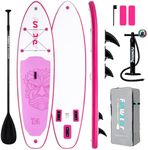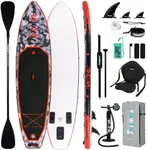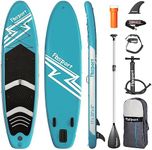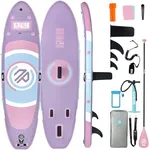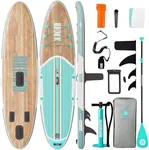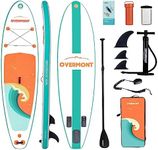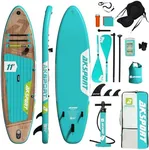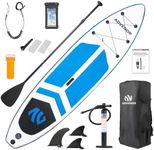Buying Guide for the Best Inflatable Paddle Boards For Beginners
Choosing the right inflatable paddle board (iSUP) for beginners can be a fun and rewarding experience. The key is to understand the different specifications and how they align with your needs and preferences. Paddle boards come in various shapes, sizes, and designs, each suited for different types of activities and skill levels. As a beginner, you'll want to focus on stability, ease of use, and durability. Here are some key specifications to consider when selecting an inflatable paddle board for beginners.Board LengthThe length of a paddle board affects its speed, stability, and maneuverability. Generally, shorter boards (under 10 feet) are more maneuverable and easier to turn, making them great for surfing or for smaller paddlers. Medium-length boards (10-12 feet) offer a balance of stability and speed, ideal for all-around use and beginners. Longer boards (over 12 feet) are faster and track straighter, which is better for long-distance paddling and racing. As a beginner, a medium-length board is usually the best choice as it provides a good balance of stability and versatility.
Board WidthThe width of the paddle board is crucial for stability. Wider boards (over 32 inches) offer more stability and are easier to balance on, making them ideal for beginners. They are also great for activities like yoga or carrying extra gear. Medium-width boards (30-32 inches) provide a balance of stability and speed, suitable for those who want to try different types of paddling. Narrow boards (under 30 inches) are faster but less stable, typically used by more experienced paddlers. For beginners, a wider board is recommended to help build confidence and improve balance.
Board ThicknessThe thickness of the paddle board affects its buoyancy and rigidity. Thicker boards (6 inches or more) are more buoyant and can support more weight, making them more stable and suitable for beginners. They are also less likely to bend in the middle, providing a more rigid and stable platform. Thinner boards (4-5 inches) are lighter and may be easier to carry, but they offer less stability and are better suited for lighter paddlers or more experienced users. For beginners, a thicker board is generally better as it provides more stability and support.
Board VolumeBoard volume is a measure of the board's buoyancy and is calculated based on its length, width, and thickness. Higher volume boards can support more weight and are more stable, making them ideal for beginners. Volume is usually measured in liters, and a higher volume means the board can float better and support heavier paddlers. As a beginner, look for a board with a higher volume to ensure it can support your weight and provide a stable platform for learning.
Board ShapeThe shape of the paddle board affects its performance in the water. All-around boards have a rounded nose and are versatile, suitable for various activities like cruising, yoga, and small waves. Touring boards have a pointed nose and are designed for long-distance paddling, offering better speed and tracking. Surfing boards are shorter with a more curved shape, ideal for catching waves. As a beginner, an all-around board is usually the best choice as it offers versatility and stability for different types of paddling.
Material and ConstructionInflatable paddle boards are typically made from durable PVC material with drop-stitch construction, which provides rigidity and durability. The quality of the material and construction affects the board's performance and longevity. Higher-quality boards will have reinforced seams and multiple layers of PVC, making them more durable and resistant to punctures. As a beginner, look for a board with good construction quality to ensure it lasts longer and can withstand the learning process.
Fin SetupThe fin setup on a paddle board affects its stability and tracking. Boards can have a single fin, 2+1 setup (one large center fin and two smaller side fins), or a tri-fin setup (three equal-sized fins). Single fin setups are easy to use and provide good tracking, making them suitable for beginners. The 2+1 setup offers a balance of stability and maneuverability, while the tri-fin setup is more common in surfing boards for better control in waves. For beginners, a single fin or 2+1 setup is recommended for ease of use and stability.
AccessoriesWhen choosing an inflatable paddle board, consider the accessories that come with it. Essential accessories include a paddle, pump, leash, and carrying bag. Some boards also come with additional features like bungee storage areas, repair kits, and detachable fins. As a beginner, having a complete set of accessories can make your paddling experience more convenient and enjoyable. Ensure the paddle is adjustable to fit your height, and the pump is efficient for easy inflation.
